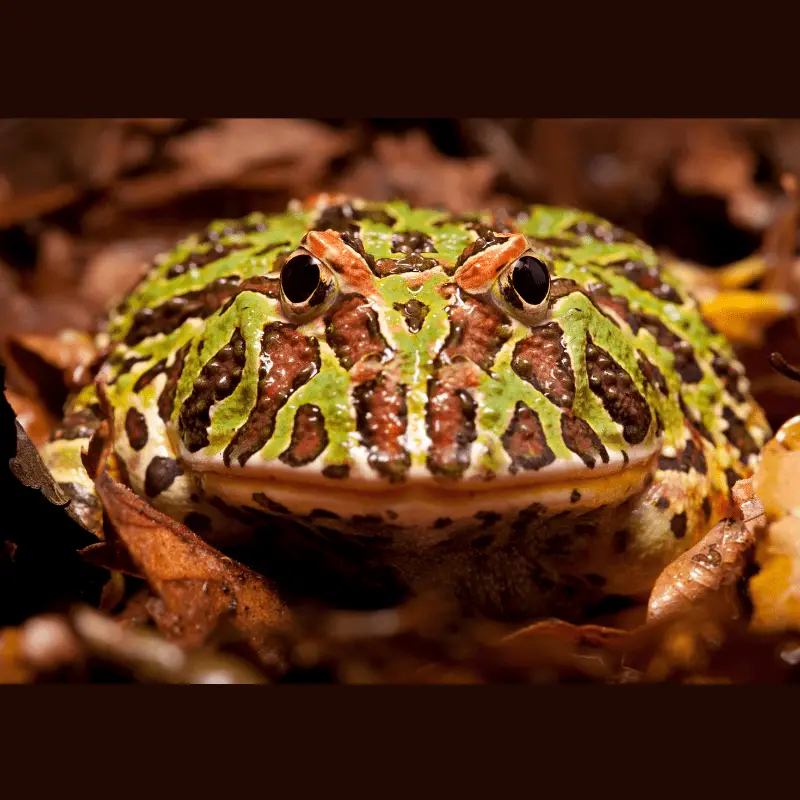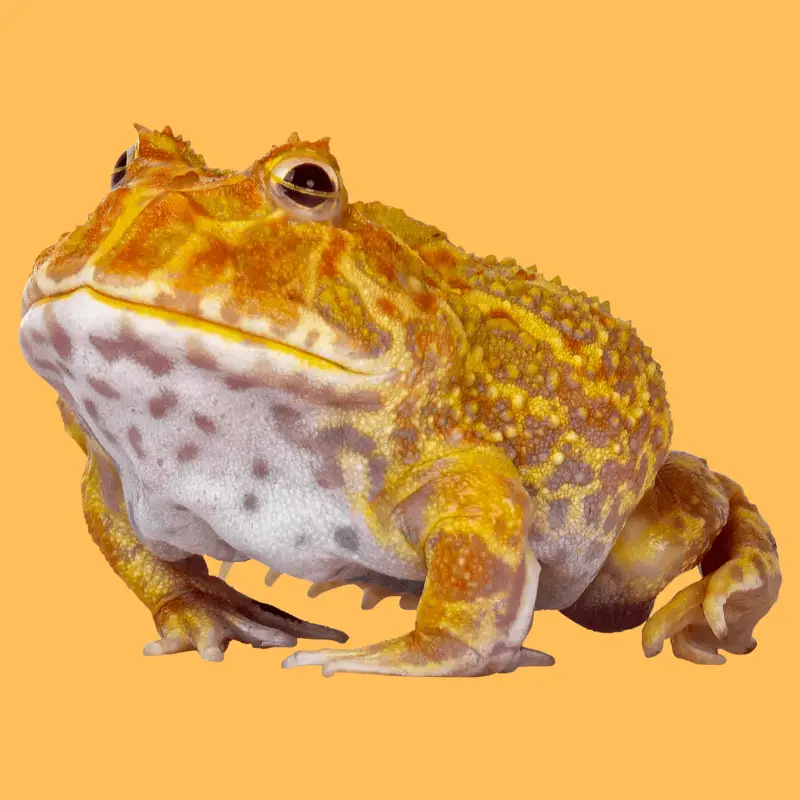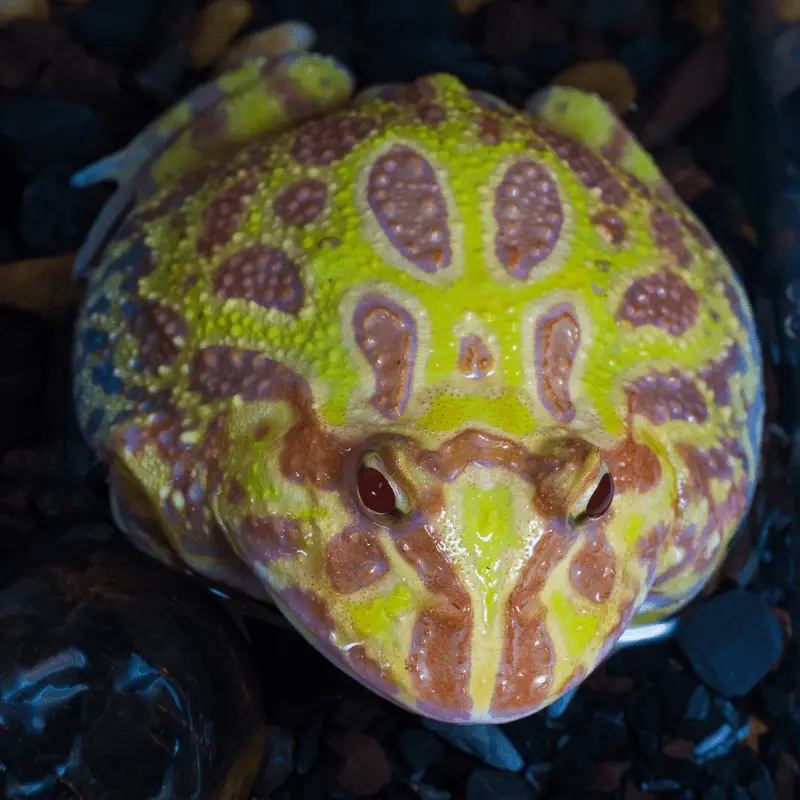Pacman frogs are one of the amphibians that are native to South America. The Pacman frog is also one of the most popular pet amphibians for its usual body shape. These frogs are strictly terrestrial. Unlike many frog species, the Pacman frogs are terrible swimmers. Instead, they prefer to spend most of the time hidden in the damp leaf litter of a humid area. They only keep their head exposed to catch their prey.
Their unique body shape also helps the frogs to hide exceptionally well. However, their camouflaging prowess does not save these frogs from their predators, like birds and snakes.
Why are they named Pacman frogs?
The name of the frog came from the popular video game Pacman Arcade. The physical appearance of the Pacman frogs is very similar to the animated character showcased in the video game. Like the animation character, these frogs tend to eat a lot and have a wide mouth that takes up most of its body.
Pacman frogs are not at all difficult pets to look after. However, if you want an active pet frog, this frog may not be a good match for you. They are very lazy and spend most of their days not moving. These frogs are known for their voracious eating habits. They would try to swallow down anything that moves. Pacman frogs mainly feed on insects, rodents, lizards, and other frogs. These frogs are so obsessed with eating that sometimes they can suffocate during the eating process. That’s why it’s important not to give any foods that are bigger than their heads.
Species overview
- Common Name: Ornate horned frog, South American horned frog, Pacman frog, Ornate Pacman frog, Argentine wide-mouthed frog, Argentine horned frog.
- Scientific Name: Ceratophrys ornata
- Size: Females 6 inches in length and 6 inches in width. Males 4 inches in length and 4 inches in width.
- Life Expectancy: These frogs can live up to ten years in captivity.
- Eating Habits: Carnivore
- Location: Geographical range is the grasslands of Uruguay, Argentina, and Brazil.
The Pacman frogs tend to spend most of their life burying two-thirds of their body inside the damp and soft grounds. These frogs are ambush predators and can camouflage themselves exceptionally well within their environment. This camouflaging ability helps the frog surprise prey of any size.
Discovery
Renowned German naturalist Prince Maximilian of Wied-Neuwied first described these frogs in the year 1824
Appearance
The Pacman frog is a unique species that rarely grows more than 6 inches. The female frogs are larger than the male frogs. Generally, adult male frogs do not get any bigger than 4 inches in size.
Size: 4 to 6 inches long
Mouth
The mouths of these frogs make up about one-third the length of their body. That gives these frogs the appearance of one giant head with a couple of legs attached to the back.

That cavernous mouth is created for containing animals like several invertebrates, some reptiles, including snakes, amphibians, and even small mammals. The interesting fact about these frogs is that they sometimes feed on their own species.
Jaw
These frogs have very wide jaw. The jaw of these frogs is as wide as their heads. Pacman frogs are strong animals with powerful Jaws. These Jaws are built for holding their prey in place during the feeding process. The Pacman frogs can hold animals almost as large as themselves with the help of their powerful Jaws. Not only that, their Jaws are filled with tiny teeth-like projections, which help them to grip the struggling prey.
Colours
You can find yellow, green, brown, white, and black colours in the bodies of this frog. The combination of all these colours helps to create a classic military camouflage look in these frogs.
You can also find beautiful albino specimens of Pacman frogs in some pet stores. Many high-quality private breeders take great pride in isolating various colours of Pacman frogs and creating frogs of specific colours and patterns through selective breeding.

Body
The Pacman frog comes with a roundish body with bumpy skin.

Legs
Thanks to their short legs, these frogs are exceptionally good at jumping.
Horns
You can recognize these frogs from the horn-like structure above their eyes as well. Some Pacman frogs have more pronounced horns than the rest, making them more desirable to pet owners.
How long do Pacman frogs live?
The average lifespan of 20 frogs is 6 to 7 years in the wild. However, in captivity, they can live up to 10 years.
Behaviour
In captivity, Pacman frogs are great pets. However, in the wild, they are known to bite when they feel threatened. The appetite of the Pacman frogs matches its eyes perfectly. It will try to eat anything that moves within the striking range, sitting on the ground. Any prey that moves around it is fair game for the frogs.
Pacman frogs are highly territorial and always prefer to live alone. These frogs are solitary creatures, and they tend to defend their territory very aggressively. Sometimes while defending their territory, these frogs attack and eat the frogs of the same species. That means if you want to keep this frog as a pet, you need to build separate enclosures for them. It is best not to keep all the frogs in the same compartment as it may lead to a fatal end.
Habitat
Pacman frogs prefer wet and humid tropical rainforests. These frogs love to stay hidden inside the leaf litter to ambush their prey. You can also find these frogs near the temporary water bodies. Pacman frogs can also be found near irrigated croplands and roadside ditches.
Reproduction
Pacman frogs tend to reach their maturity between 18 to 24 months of age. During the mating season, male frogs create a loud noise to attract the attention of the female frogs. Generally, these frogs mate in a small pool of water. The rainy season of the late spring is considered the mating season. At any one time, a female Pacman frog can lay between 1000-2000 eggs per mating season after successful fertilization. The female frogs wrap these eggs around the aquatic plants. It takes about two weeks for these eggs to hatch into tiny tadpoles.
Conservation status
The Pacman frogs are considered a vulnerable species and are listed as near threatened frog species. The international community of researchers has explained that these frogs are close to landing a place on the endangered species list. There is plenty of evidence that the population is declining rapidly.
The reason for this sharp decline:
- Lack of food sources
- Captive breeding
- Habitat destruction due to agricultural land acquisition
Diet
Pacman frogs are carnivores. They hunt their prey by staying motionless in a specific spot for a long time and patiently waiting for the prey to come close to them. They will try to eat anything that they can fit in their mouth. Sometimes, these frogs try to eat animals that are bigger than themselves. In the wild, these frogs typically feed on rodents, spiders, small reptiles, and insects.
These frogs are known for their exceptional Fearless demeanour. If threatened by larger animals, like humans, these frogs get aggressive and deliver a painful bite.
Even though these frogs do not have real teeth, they have several bony projections on their upper and lower Jaws. These frogs use these bone stumps like teeth to keep their prey in place during the feeding process. When these frogs bite someone, these tooth-like boney structures can cause significant injury. These frogs sometimes jump towards the attacker irrespective of the power or size they face. However, in captivity, these frogs are pretty easy to handle as a pet. Pacman frogs are generally fed large crickets and mice. Depending on their size, these Pacman frogs also love to eat fish.
List of foods:
- Crickets
- Dubia roaches
- Mealworms
- Superworms
- Mice
- Waxworms
How often should I feed my Pacman frog?
You should feed your Pacman frog every two to three days whilst ensuring that the food has been dusted with vitamin D and calcium. Dusting the food before offering it to your Pacman frog is vital for its survival.
Handling
In captivity, Pacman frogs do not respond well to handling. However, you shouldn’t handle them too much as they can become excessively stressed if you hold them regularly. If you think that you need to handle your Pacman frogs, make sure to wash your hand vigorously to avoid passing unwanted germs. Always handle your frog with moistened hands. Create a cup-like position with your hands so that you can stop your frog from jumping out of your grasp.
While reaching for the frog, you should always be careful. While the Pacman frogs are not aggressive when they don’t feel threatened, they have a tremendous hunting reflex, and the powerful jaws of an adult can significantly damage your hands.
Defence Mechanism
These frogs can also shoot out blood from their eye ducts which help to confuse their predators in the wild. Often, this blood contains toxins that are fatal to predators, like coyotes, wolves, and dogs. The blood can travel as far as three feet to the target. The blood also tastes disgusting to the preditors, which immediately puts them off eating. The preditor will retreat from the frog, and the Pacman frog can go about his business sitting doing nothing, awaiting some sizable prey to come near.
Housing The Pacman Frog Advice
As these frogs are not that active, they do not need a large enclosure. You can arrange a 20-gallon tank if you want to keep these frogs as pets. As these frogs will try to eat any of their cage mates, you should keep one frog alone in the single enclosure. Maintaining the correct humidity and the temperature of the terrarium is very important.
You can fill the tank up with smooth rocks or paper. Spray the substrate with water to keep it moistened. Depending on the humidity of the terrarium, your Pacman frog might want to spend most of its time in the water. However, you should always provide litter or moss for hiding. Keep moss or other plants around the water dish to help your frog feel more secure. You should also keep the water in a warmer spot inside the terrarium to not get too cold.
Heat
To create the temperature of the humid forest of South America, you should keep the temperature of the water tank around 82 degrees Fahrenheit during the day. The tank’s temperature can slide down to 78 degrees Fahrenheit at night, but no less than that. Use under tank heater to keep your terrarium warm. It is always better to use this type of heating device compared to the overhead incandescent bulbs. These bulbs can be drying for the skin of your frog, leading to various health issues.
Light
You can fix a fluorescent light inside the terrarium. However, Pacman frogs do prefer subdued lighting. Don’t forget that this frog generally lives on moist and dark forest floors. It is better to keep a 12 hour subdued light and 12-hour dark cycle to maintain a natural environment.
Common Health Problems
Bacterial and fungal infections are some of the common elements of the Pacman frogs. If you notice any out of character marks on the skin of your pet frog, you should consider it to be a sign of infection. Most of the Pacman frogs are susceptible to parasitic infections. If you think the tank’s temperature is correct and your frog is still not eating correctly, you should seek help from an exotic vet. You can also try to check the faecal sample of the frog once a year to make sure it is not suffering from parasites. You can catch it quickly if you do this.
Another factor is humidity. Unlike most other amphibians, if you keep a Pacman frog in an enclosure that does not have enough moisture, your frog may develop severe respiratory problems. Drooling, wheezing, and lethargy are some of the most common signs of this problem. This problem occurs when the waste of the Pacman frog is not properly cleaned away, so it is imperative to have a strict tank cleaning regime. Also, it would help if you kept an eye out for ammonia poisoning.
How often should I clean my Pacman frogs tank?
Every three weeks, the tank will require a change in the substrate and a clean. By doing this, your Pacman frog will thrive in a clean and healthy environment.

